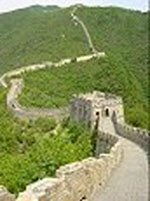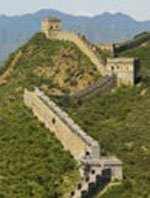The Great Wall of China

The Great Wall of China is a must see attraction, It is, indeed an experience of a life time.
Who would leave the China without seeing the only construction on earth visible by the naked eye from space?
The Great Wall of China starts from Shanhaiguan Pass, a seaport along the coast of Bohai Bay in the east, to Jiayuguan Pass in Gansu Province in the west, covering 16 provinces, cities and autonomous regions in China. It is more than 6,000 Km.
The Great Wall of China traverses many mountains and gullies, a countless number of inner walls, outer walls, fortified towers, signal beacon towers, fortifications and garrisons complete this complex structure, all make up what we now call today the Great Wall of China.
Those who succeeded in climbing the wall today will understand the difficulty in climbing it, all then can imagine how difficult it was to build the Great Wall of China without modern machinery at that time.
In Beijing the Great Wall is about 630 km long; there are four sections that are the most common places to see the Great Wall.
They are Badaling Section, Juyongguan Pass, Mutianyu Section , Simatai Section.
I have written some info about each section, please see below.

Some of the Great Wall's History
China had been building sections of the Great Wall since before it was a nation. That part now identified as Wan Li Chang Cheng, or the 10,000 Li Wall, is believed to have been started in the Spring and Autumn Period (770-476 B.C) and the Warring States Period (475-221 B.C). Both were time for great tumult in China.
In this Warring States Period of 7th century B.C, many dukedoms built walls in Central China to protect themselves and their northern territories. When Qin Shihuang, the first emperor in Chinese history, unified China and established the first centralized feudal state in China, he decided to have the walls linked up and extended.
When Qin Shihuang, the first emperor in Chinese history, unified China and established the first centralized feudal state in China, he ordered that the northern sections of the Walls built by different dukedoms be joined and made into one defensive wall. Emperor Qin Shihuang sent General Meng Tian with an army of 300,000 forced laborers for the mission and built part of the new wall. That was the Qin Great Wall-From Lintao in Gansu Province in the west to Liaodong in the east.

The Great Wall started from Lop Nur in Xinjiang Uygur Autonomous Region to Liaodong in the east, which stretched about 10,000 Km. The following dynasties, except the Tang Dynasty when the Great Wall was all within the boundary of the Great Tang Empire, the Great Wall was under constant construction and repairing. Today, you may find some remnants of the wall scattered in the northwest of China, but not in the eastern part of China.
There were about one million people, one-fifth of China's population at the time, were involved in the project, which took more than ten years. Most of the walls we see today were rebuilt during the Ming Dynasty in the 16th century. the Great wall extends from Shanhaiguan Pass in the east to Jiayuguan Pass in the west.
The Ming Dynasty was the last dynasty in Chinese history when large scale construction of the Great Wall took place, and most of the walls we see today were built in the Ming Dynasty. The Ming Great Wall stretched from the Yalu River in the east to Jiayuguan in the west, covering a total length of more than 5,000 Km. At present, however, Shanhaiguan Pass is generally considered as the eastern end of the Great Wall of China because the section from Shanhaiguan Pass to the Yalu River was poorly built and maintained. Shanhaiguan Pass is also considered as "the First Pass Under Heaven".
The Qing rulers did not continue building the Great Wall, they adopted a new policy by building a Summer Resort in Chengde to entertain the Mongolian and Tibetan nobles to ensure a peaceful boundary.
The bricks, rocks and lime used to build the Wall had to be carried up the mountains at the cost of back-breaking labor, moreover, goats and donkeys carried the earth and bricks in baskets, some of the rocks were moved up slopes by means of rolling rods and hoisting bars. It is hard to calculate the amount of labor used in the construction of the Great Wall of China.

In ancient China, military information was distributed through horse riders and beacon-towers. In easy accessible areas, emergency military information was conveyed from one station to another by riding horses-at each station, the horses should be changed and supplies refilled.
However, in the Tang Dynasty, when the whole country is not at war, horses were used to carry fresh Lichii to Chang'an, the capital at that time for the emperor's most favorite concubine-Lady Yang Yuhuan. Du Fu, a famous poet in the Tang Dynasty wrote certain poems to criticize the corruption of the emperor.
In the mountainous area, on the other hand, it was extremely difficult for the horses to send messages; therefore, beacon towers were built along the wall to relay information from place to place. When the enemy invaded in the daytime, wolves dung was used to burn for a strong smoke, while at night, beacon fires were lit on the towers to give a warning message.
The reason wolves is that there were many wolves in the region and wolves dung could easily be found, another reason is that the wolves dung gathered closely and went straight upward so it can easily be seen from afar. Moreover, the number of the smoke signals could reveal the number of invading enemies. One smoke used to represent 100 enemies, two smokes, 500, and 3 smokes, 1,000 etc, and the amount of smoke or fires expressed the degree of emergency.
Badaling Section

Badaling means, "Giving access to every direction", the name itself suggests its strategic importance. The Badaling section of the Great Wall lies in Yanqing County, northwest of Beijing This section of the Great Wall is perhaps the best known, and visited by countless foreign travelers. Badaling section is a well-preserved part of the Ming Great Wall; at this point, the wall averages 7.8 meters high, 6.5 meters wide at the base and 5.8 meters at the top. The wall was designed to allow five horsemen or ten soldiers to march side by side along the wall.
The Badaling Section of the wall is the site of the most visited section, approximately 50 miles northwest of Beijing city within the Beijing municipality. The portion of the wall running through the site was built during the Ming Dynasty, along with a military outpost reflecting the location's strategic importance.
This portion of the wall at Badaling has undergone heavy restoration, and in 1957, it was the first section of the wall to open to tourists. Now visited annually by millions, the immediate area has seen significant development, including hotels, restaurants, and a cable car. The recently completed Badaling Expressway connects Badaling with Beijing city.
Juyongguan Pass

Juyongguan Pass lies 50 Km northwest of Beijing , it is located in a 15 Km long valley. The section is very near Badaling , just a little south, in Changping County . This Pass was connected to the Great Wall in the Northern and Southern Dynasties. It spans one of the nine narrow passes crossed by the Wall. Many passes were built at strategic points along the wall, and the Juyongguan Pass was one of them. Besides its strategic significance, this pass was also famous for its beautiful scenery. In fact, in the Jin Dynasty (1115-1234 A.D), this place was listed one of the Eight Best Scenic Spots in Beijing.
The gate in the center of Juyongguan Pass was built of finely carved marble and called Cloud Terrace or Guojie (crossing-street) in Chinese. This building was originally the base of three towers and was built as early as 1345, more than 500 years of history now, this marble Cloud Terrace is nearly 10 meters high, the bottom is 27 meters long from east to west, 15 meters wide from north to south. Seen from distance, this terrace is bigger at the bottom and smaller at the top.
Originally, on the top of the cloud terrace stood three towers, but an earthquake in the early Ming Dynasty destroyed the three towers on the top, only the terrace itself left. An arch gateway is underneath the terrace, which is more than 7 meters high, 6 meters wide, wide enough for carriages to go through. Both side of the arch gateway are decorated with carvings of Buddha’s, four Celestial Kings, and the text of a Buddhist Sutra in Chinese, Tibetan, Sanskrit and 3 other minority languages.
The Mutianyu Section
In the northern part of Huairou County, 70 kilometers northeast of Beijing , the Mutianyu section of the Great Wall winds its way for over 2000 meters. This section is well preserved and is a good alternative for visitors who would like to avoid crowds along the highly popular Badaling section during holiday and peak seasons.
The construction of this section started in the mid-6th century during China's Northern Dynasties (386 - 581) and what now remains is the main restoration made during the Ming Dynasty (1368 - 1644). It has served as a northern barrier of what is now Beijing through the ages. Connected with Juyongguan Pass in the west and Gubeikou Gateway in the east, this section was built along steep ridges and deep valleys, this section is renowned for its unique fortifications.
Simatai section

To the east of the Jinshanling stretch of the Great Wall, there lies the quiet and remote Simatai section The ruinous state of this part of the Wall gives it an air of authenticity that has earned it the reputation of being the most beautiful section of the Great Wall. Unlike the sections to be seen at Badaling or Mutianyu that have undergone extensive restoration, the wall at Simatai has received very little attention. Here, the wall really looks, as one would expect it to look some 500 years after it was built during the Ming Dynasty. The local people are proud of this monument and proclaim that it was because of visiting at Simatai that UNESCO was convinced the wall should be listed as a World Heritage site. It towers over the nearby villages and farmland as it winds its way like the spiny back of a dragon over the sharply clipped peaks of the mountains.

Because this section has retained much of its original, 500-year-old features it offers a quite hazardous passage to those who wish to walk along it. These difficulties offer a challenge that is irresistible to dedicated hikers in quest of adventure. An additional attraction is that as Simatai is 130 kilometers (80 miles) to the north-east of Beijing it is well beyond the reach of the huge crowds of tourists that throng the more popular and accessible parts of the Wall.
